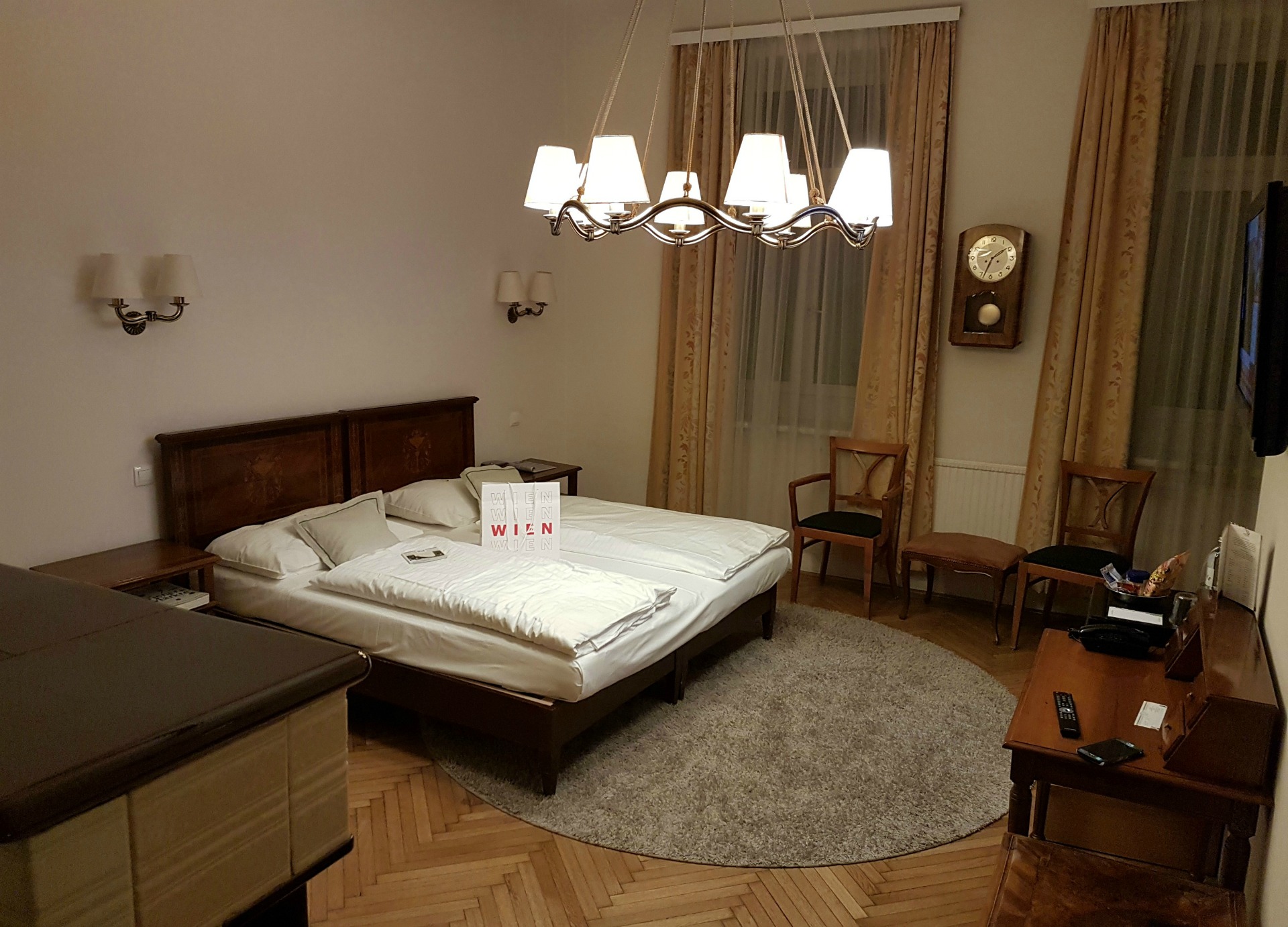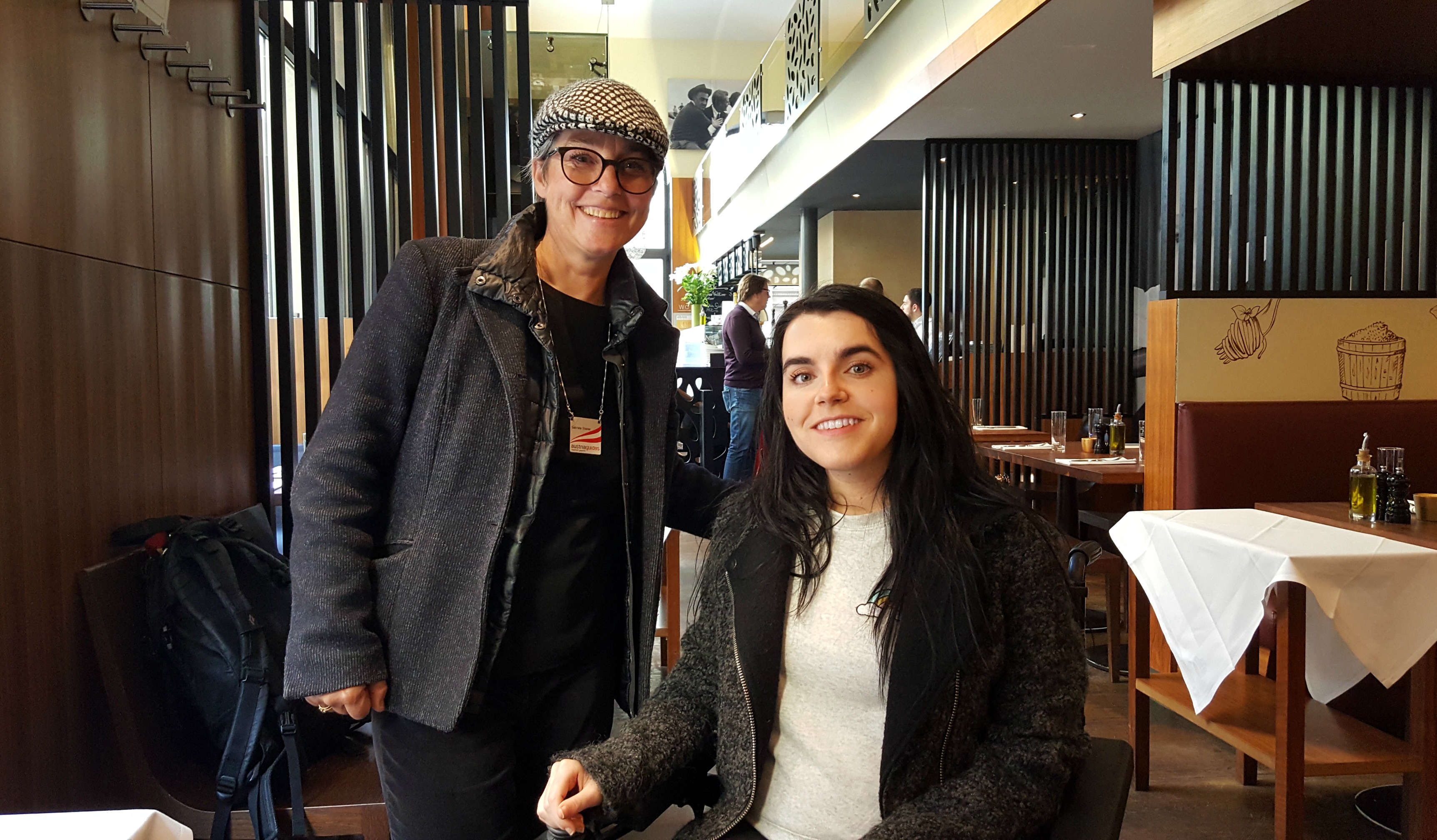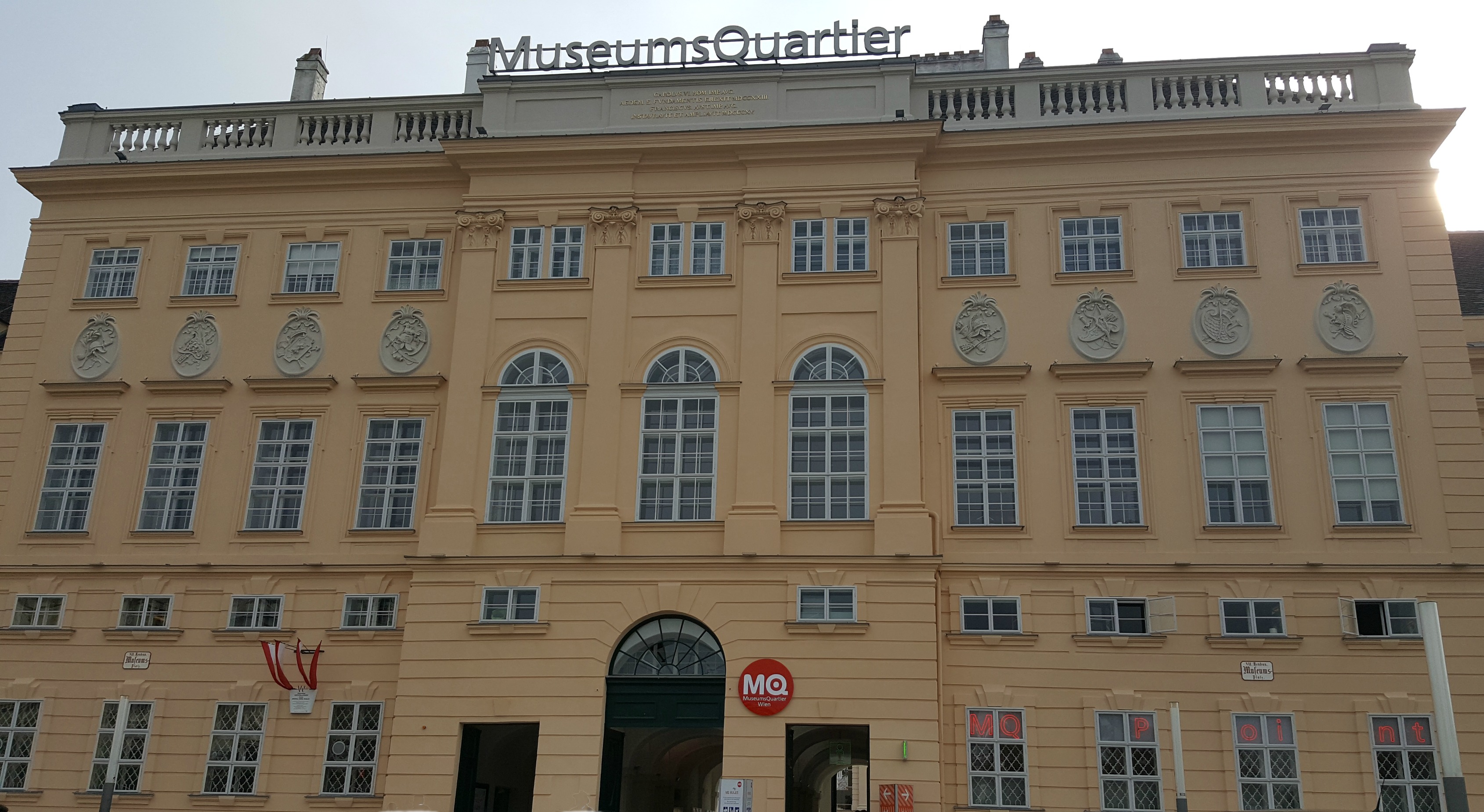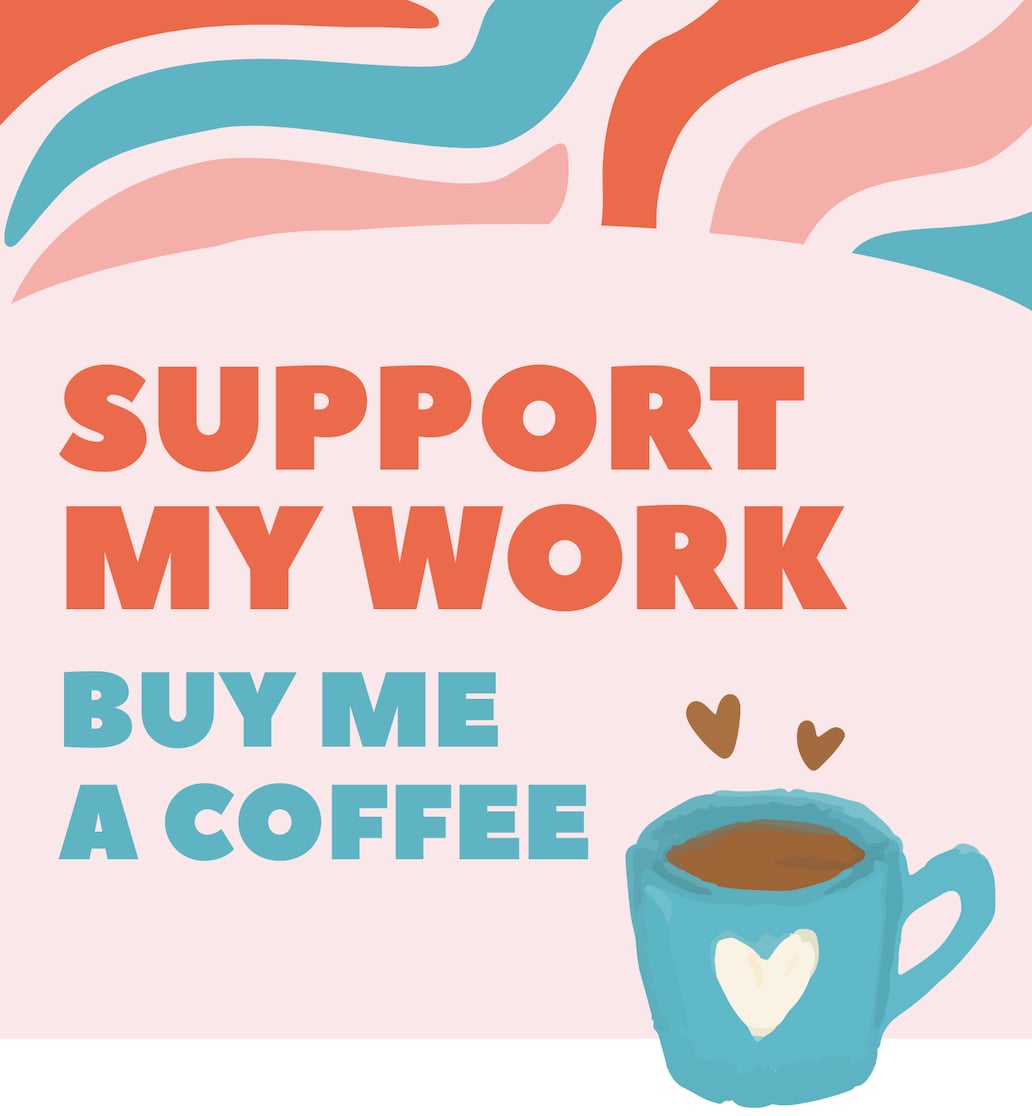Vienna had been on my travel bucket list for such a long time, so when I finally visited this beautiful city, it felt all the more special. We spent four nights in Vienna, which gave us three days to explore and see the sights. We had the best time exploring this charming Austrian city and hope to return in the near future. Until then, here is my ultimate city guide to Vienna for wheelchair users, including where to stay, what to see and do, where to eat, and how to get around.
Where to Stay
Vienna has some of the most beautiful architecture, Art Nouveau, and Gothic styles. It’s one of my absolute favourite cities for its charm and beauty.
So when it came to the type of hotel to stay in, we were lucky to experience two different hotels with very different styles. One is authentic Viennese and the other is trendy and modern.
Regardless, both hotels were amazing in their own right, and I’d definitely stay at them again when I return to Vienna.
Boutique Hotel Donauwalzer


Dating back to 1901, Hotel Donauwalzer is a real Art Deco gem with so much charm and authenticity. Being a family-run hotel you get a true sense of tradition, hospitality and love. All the staff are very friendly, helpful, and genuinely happy to be there.
Our accessible room was lovely and had so much space for moving around in my power wheelchair. The breakfast was amazing and incredibly fresh. Aside from that, the hotel was within walking distance of the city centre but also had great public transport links.
Read my full hotel review: Boutique Hotel Donauwalzer: The Most Charming Place to Stay in Vienna
Location: Hernalser Gürtel 27, 1170 Wien
Amenities: Free WiFi, Breakfast Buffet, Concierge, Pets Welcome, Bar/Lounge, Garden, Private Spa
Hotel Schani


Having just opened in 2015, Hotel Schani is aimed at tourists looking for convenience and modern technologies. The hotel bed is amazing and I had the best sleep I’ve ever had in a hotel. The décor is super cool and the deliciously healthy breakfast will have you revitalised for a busy day of sightseeing.
You can’t go wrong with this hotel, as it’s in an excellent location for public transport with Vienna’s Central Railway Station right across the street. With tram line D on the hotel’s doorstep, catching a tram into the city centre couldn’t be easier, and you’ll be off exploring the attractions within 7 minutes.
Read my full hotel review: Hotel Schani: The Most Trendy & Eco-Friendly Hotel in Vienna
Location: Karl-Popper-Straße 22, 1100 Wien
Amenities: Free WiFi, Breakfast Buffet, Pets Welcome, Bar/Lounge, Garden, Self Check-In
What to See
The Stephansplatz


The Stephansplatz is the main square in the heart of Vienna. Filled with restaurants, shops, musicians, and street performers. You’ll never be short of things to see and do.
The outdoor restaurants provide the perfect setting for people watching while enjoying the beautiful sounds of live music. I’ll never forget the calm feeling of listening to an amazing young girl play ‘My Heart Will Go On’ on her violin one night. It was so good!
A little boy around three years old became besotted with her and kept running up and dancing in front of her. It was adorable.
Top Tip: Need the toilet while strolling through, but not sure where has an accessible toilet? Head for the Stephanplatz U-bahn via the lift (directly across from St Stephens Cathedral). The accessible toilet is locked, so if you don’t have a Euro Key then the attendant will unlock it for you.
Admission: Free
St Stephens Cathedral


Another reason to roll along Stephansplatz is to admire the 14th-century St Stephan’s Cathedral. One of the city’s most important and recognisable buildings due to its history as well as its Romanesque and Gothic appearance.
Part of what makes it most recognisable is its multi-coloured chevron-tiled roof, which provides a stunning contrast against the blue sky.
If you’re feeling a bit lost and not quite sure where you are, just look for its 137-meter-high spire and head in that direction, bringing you back into the centre of the city. (We relied on this handy technique many times)
The main entrance is wheelchair accessible, and guided tours of the Cathedral are available. However, tours of the catacombs and evening tours include a tour of the roof, which is only accessible via steps; therefore, they are not wheelchair accessible.
Don’t let this deter you from visiting this stunning Cathedral, as you’ll still be able to admire the inside and get a sense of how old this beautiful building is. There was a mass taking place when we arrived, so it’s important to be quiet and respectful to others.
Top Tip: Visit later in the day or at night for fewer crowds.
Fun Fact: Mozart was married here in 1782.
Admission: Free for disabled and carers.
Albertina


The Albertina is one of the best art museums in Vienna with an incredible collection of over 60,000 drawings and one million prints. This impressive collection includes art pieces from Monet, Picasso, Da Vinci, Cézanne and Egon Schiele, whose exhibitions we were particularly interested in seeing.
Wheelchair access is available throughout the museum, restaurant, and shop. You’ll find accessible toilets located on Level 1 and Level -1, which are accessible via lifts.
Admission: Reduced admission for people with disabilities €7.
Burggarten Park


No matter where I go or the city I visit, I always find myself heading for some green space to relax and take a break from the crowds. Vienna was no exception, with so many beautiful parks to choose from, such as Burggarten, which is situated right next to the Imperial Palace Hofburg in the 1st district.
Not only is this one of Vienna’s most beautiful parks, but it also contains the famous Mozart monument. Burggarten is the perfect spot to relax or enjoy something to eat or drink at the Palmenhaus, a large art nouveau glasshouse that is also home to hundreds of exotic butterflies.
There’s nothing worse than a bumpy, uneven path while you’re trying to relax, but thankfully, Burggarten has smooth, accessible paths throughout, which helps with the feeling of pure relaxation.
Top Tip: Roll up the sloped path on the right-hand side of the park to reach the Palmenhaus and enjoy a drink in the sunshine.
Admission: Free admission to Burggarten Park. The butterfly house is free for disabled visitors and carers.
Accessible Walking Tour


Walking tours are a great way to get an overview and see the main sights during a city break. They are particularly helpful if you’ve only got a few days to explore the city and want to squeeze in as much as possible. I know we do! At the same time, we also don’t want to be rushing about frantically trying to tick off “Vienna’s top attractions”.
Instead, we like to explore parts of the city that tourists typically don’t see. That’s where an accessible walking tour comes in.
We had a fantastic tour guide, Gabriela Steiner-Scharfetter, who took us on a 3-hour tour covering ‘accessible Vienna’ and it was the best city tour I’ve ever been on. Gabriela was extremely friendly, knowledgeable, and charismatic.
We covered the main sights within the centre and out with the ‘typical’ tourist routes. We saw buildings and streets and learned so much more than we ever would have if we hadn’t been on the tour.
It was fascinating to listen to Gabriela’s stories of Vienna, giving us real insight and appreciation into Vienna as well as advice on the best restaurants and cafes where locals go.
It would be lovely to go on another tour with Gabriela when we return to Vienna.
Haus Der Musik


If you’re looking for a fun and interactive museum, then the Haus der Musik (House of Music) is for you. As the name suggests, this museum is all about music and sound, but it’s displayed in a really cool and interactive way that encourages visitors to experiment with the different exhibits.
There are lifts throughout the four floors, as well as a staircase that acts as a piano as you step on it. This in itself can be a lot of fun, even to watch others create a tune as they climb the stairs.
Top Tip: Open daily until 10 pm – we visited at 8 pm and there were fewer crowds.
Admission: Reduced admission for people with disabilities is €9, carers receive free admission.
Naschmarkt


The Naschmarkt is Vienna’s most popular market, with over 120 market stands and restaurants. You’ll find everything from fruit, vegetables, spices, baked goods, souvenirs, clothes, home goods, and more. There are three lanes of stalls, and each is quite long, so you could easily spend a while looking at everything.
The Naschmarkt can get very busy, so we arrived around 11 am when it was still quite quiet, which made it easier for me to move around in my wheelchair. We left just before 12 pm and noticed it was starting to get busier for lunchtime. There is a flea market every Saturday, which has become part of Vienna’s culture.
Top Tip: Visit outside of usual meal times for a quieter experience.
Admission: Free
Museumsquarter


Located in Vienna’s 7th district, Museumsquartier is one of the world’s largest art complexes. Packed full of great museums and culture, all in one area. With museums such as Leopold, MUMOK, and Kunsthalle, as well as a selection of trendy restaurants, cafes, bars and shops.
You’ll enjoy complete wheelchair access throughout Museumsquartier with lifts and accessible toilets. The inner courtyard is lovely and perfect for relaxing after hours of exploring the museums.
Its modern look is a stark difference from the Gothic architecture throughout the rest of Vienna.

Top Tip: Don’t miss the street art passageways at Museumsquartier for public exhibitions of art and graffiti artists.
Admission: Free to enter the courtyard, but there is admission to each museum. Discounts apply with the Vienna City Card.
Where to Eat
I have to admit we ate pretty well in Vienna, as the food was amazing. I’d go back to Vienna just for the food alone. As breakfast is the most important meal of the day, and because we had busy days ahead of us, we took full advantage of the amazing breakfasts at the hotels.
Breakfast was included in both of our hotel reservations, which was good because it meant we didn’t have to rush to get ready in order to leave the hotel and hunt for somewhere to eat.
For lunch and dinner, we didn’t have to look too hard as there were so many lovely Viennese cafes and restaurants, as well as street food on every street. Some restaurants had a step up, and we couldn’t see any visible ramp, although there might have been.
But we always managed to find somewhere we wanted to eat, and since the weather was so good, we enjoyed sitting outside whenever we could. We enjoyed eating at the following restaurants and cafes:
- Sopranos – We enjoyed a nice lunch at this Italian restaurant near the State Opera
- Da Mortiz Huth – The dinner at this lovely restaurant was amazing.
- Chilai Ringstrassen – I had a few people comment on how good my falafel salad looked.
- Da Gennaro – A nice little restaurant along a little side street off Stephansplatz.
- Café Bellaria – Stopped off at this authentic Viennese coffee house before heading into the Museumsquartier. The waiter was amazing and thought I was asking for apple strudel when, in fact, I was asking for a straw for my drink. #ScottishAccentProblems
- Hotel Schani – The best vegan lentil stew I’ve ever tasted
How to Get Around
Airport transfer

We had airport transfers booked as part of our organised trip. The company that transferred us to and from the airport was called Blaguss, which specialises in travel and transportation. The Blaguss minibus driver was waiting for us in the airport’s arrivals area, holding a sign with our name.
The minibus offers great accessibility for wheelchair users and is equipped with a foldable ramp. I was impressed by its high standard and approach to wheelchair securement and safety. The drivers were also very good and ensured I was okay at all times.
I’d definitely use Blaguss again when I next visit Vienna.
On foot/wheels

One of the things I dread when visiting a European city is the cobblestones. Thankfully, there aren’t many in Vienna. The streets and paths throughout the city of Vienna are in excellent condition. I was able to easily and comfortably get around in my powered wheelchair without any problems.
I believe the best way to get a true sense of a city is to walk or roll through it, wander along little side streets, and see and experience things rather than whizzing by on public transport.
Top Tip: Explore the side streets and admire the authentic Viennese cafes and shops.
Bus

We only used the bus (autobus) once during our trip, but found the experience absolutely fine. “Low floor” accessible buses are in use on all bus routes and have folding ramps, as well as priority wheelchair spaces.
It’s important to make yourself visible to the driver so they are aware you wish to board, and press the wheelchair button when you’d like to exit.
Top Tip: Prepare yourself for a loud bang when the ramp unfolds and hits the ground. Some bus drivers are gentler than others.
Tram

Once we figured out the tram line map and understood which line we needed, it became our preferred method of getting around Vienna. The tram journeys always seemed very quick, and it took us only 7 minutes to get into the city centre from Hotel Schani.
Most trams are accessible, but you may have to wait for the second tram for it to be an accessible (low-floor) tram.
You’ll see a display at each tram stop showing a blinking wheelchair symbol indicating how many minutes until an accessible (low-floor) tram will depart. We never had to wait too long.
Before boarding the tram, make sure you position your wheelchair in line with the first car and make yourself visible to the tram driver. The driver will then come out and unfold the ramp to allow you to board the tram.
The wheelchair space is directly in front of the door, so you may want to manoeuvre and reverse into the space as this may make exiting easier. Just press the wheelchair button when you want to exit, as this will alert the driver, who will then unfold the ramp again.
Top Tip: Once you board, position yourself quickly as the tram pulls away sharply (I quickly learned my lesson on this when I began skidding down the tram car in my powered wheelchair – not my proudest moment, but at least I can now look back and laugh about it).
Underground subway (U-bahn)
We didn’t use the U-bahn during our time in Vienna, but we are likely to try it the next time as the newer trains are accessible.
Almost all stations are wheelchair accessible however, it’s important to check that all stations involved in your journey are accessible and in working order on the day of travel.
Unlike boarding a tram, you will board the U-bahn from the last car.
Detailed accessibility information about public transportation in Vienna can be found on the Vienna tourism website.
Bonus Tips
Vienna City Card
The Vienna City Card is a great way to save money during your trip to Vienna. Free travel on public transport such as the subway, bus, and tram, as well as discounts on tourist attractions. Opt for a 24, 48 or 72 hours card and enjoy over 210 benefits. To find out more about the Vienna City Card and to buy the card click HERE.
Accessible Toilets
Most of the main tourist attractions will have accessible toilets. However, if you’re not at one of these attractions and need the toilet, don’t panic! Just head for the nearest U-Bahn station by looking for the big blue ‘U’ sign. You’ll find an accessible toilet there. The toilet may be locked, so just ask an attendant to unlock it if you don’t have a Eurokey.
3 Days in Vienna
So there you have it, my three days in Vienna ultimate city guide for wheelchair users. I hope some of the tips and suggestions are helpful when planning your Vienna itinerary so you get the most out of this amazing, accessible city.
Vienna is doing a fantastic job of making the city “barrier-free and accessible” for wheelchair users, and I highly recommend you visit. You won’t be disappointed!
Have you been to Vienna before? If not, I hope after reading this city guide that you now want to visit as much as I want to go back.
You might also enjoy
A Wheelchair Users Travel Guide to Amsterdam
The Ultimate Guide to Wheelchair Accessible Barcelona
Vienna Photo Diary
Don’t miss a thing!
Follow me on Facebook | Instagram
My trip to Vienna was organised by the Vienna Tourist Board. I was kindly welcomed as a guest by Boutique Hotel Donauwalzer and Hotel Schani. As always, all views and opinions expressed here are my own and have not been influenced or approved.
Sharing is caring!








14 Responses
I would love to visit the St. Stephen’s Cathedral someday! I could imagine it’s wonderful architecture! How was their coffee?
Thanks for sharing your experience!
Oh Erica, I really hope you manage to visit it one day – you will love it! Vienna is famous for it’s coffee houses, but I’m not a coffee lover so I didn’t try any 🙂 You can let me know what you think of the coffee when you visit 😀
Dear Emma, thank you for sharing the information about your trip in Vienna. It is very helpful since I travel with my wheelchair on June from Athens.It’s so important for all of us as a wheelchair users to share the experience of traveling accessibility. I wish you the best
Sophia
Hi Sophia. Thank you so much for your lovely comment. I’m delighted this post has been helpful to you for your upcoming trip to Vienna. I’m sure you will have a fantastic time and please let me know how it all goes – I’d love to hear about it. I completely agree – I love being able to share my travel experiences in the hope that it is helpful to someone else. Thank you again and have an amazing trip.
Thank you for sharing your adventures. We are heading to Vienna in late May then on to Switzerland. We are from the US. Not sure about Museum discounts for us. I am interested in the Eurokey. I was able to get a key for the toilets for England (several years old called the RADAR key). Not sure it’s the same. I’d appreciate any info you have. The link for the Eurokey doesn’t seem to work.
Hi Gloria. Thank you so much for your comment – it’s lovely to hear from you.
That’s wonderful you are heading to Vienna and Switzerland next year. I’d love to visit Switzerland. I have added some info about Museum discounts/admission in this post for Vienna, but unfortunately, I don’t have any info for Switzerland at the moment.
That’s great you were about to get the RADAR key, sadly the Eurokey is different to the RADAR.
Thanks again and have a wonderful trip 🙂
Emma, I love this blog! I am currently binge-reading it in preparation to study in Europe next year. (I am a US student with mobility issues, will most likely be using a mobility scooter).
I do have a question regarding the Eurokeys. Exactly how do I get one? I do not know what kind of documentation they would want, especially given I am not from an EU country. Is there someone to contact?
Hi Alyssa. Thank you so much for your comment and taking the time to read my blog post – very much appreciated. That sounds amazing to study in Europe. What will you be studying? I hope you manage to get a hold of one and good luck for your studies abroad. Let me know how you get on 🙂
Wonderful article Emma – definitely bookmarking for later, as have a trip planned to Vienna (supposed to be later this year, but plans are forever being pushed back these days). Taking Nightjet from Brussels (overnight train – accessible cabin – should be “interesting”).
Did you visit/consider a visit to the Opera? Sounds very possible (there are wheelchair spaces in both the stalls and circle). Always looking for more information though.
Thanks.
Thank you so much, Iain. I’m delighted you found this post helpful. I really hope you manage to visit Vienna later this year. Please keep me posted and let me know how you get on when you do. I’d love to hear all about it especially the Nightjet. Sounds exciting.
Unfortunately, we didn’t visit the Opera. If we had more time, we definitely would have – hopefully the next time we go. It would be great to find out what you think of the accessibility at the Opera if you go.
Thanks again for your comment. I hope you are keeping well. Take care, Emma.
Thank you dear Emma for this helpfull wonderful article.
Can we enter the bus /tram with a scooter? It is easier for me to move with my scooter than with my wheelchair.
Hi Hedva. Thank you for your comment. I’m delighted you found this post helpful. Unfortunately, I can’t say for sure what the accessibility is like for mobility scooter users on the bus/tram. I’m sorry I can’t be of more help. I hope you have a wonderful time in Vienna. Please let me know how you get on.
I enjoyed reading your article very much! I recently purchased a power wheelchair, and have been getting around quite nicely in all the public transportation, except I have not tried a bus yet. One thing I wanted to correct, however, is that you can enter the U-Bahn from both front and back, not just the back. The new Flexity trams are excellent to ride in as they offer almost flat ramps. I tend to go in forward, turn around when I am in, so that I can exit going forward too, since backing out is quite tricky.
Because your article was so indepth, I plan on making a lot more sightseeing trips. I am an American who came to Vienna in 2008, and then became a citizen in 2021. I love Vienna!
Hi Richard. Thank you very much for your comment, I appreciate it. I’m so pleased you found this article in-depth and that it has inspired you to make more sightseeing trips. I also want to thank you for letting me know about the flexity trams and that its possible to enter the U-Bahn from both the front and back. That is very helpful to know. I really must visit Vienna again. Do you have any recommendations of places in Vienna that I should visit?